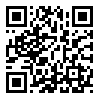BibTeX | RIS | EndNote | Medlars | ProCite | Reference Manager | RefWorks
Send citation to:
URL: http://hakim.tums.ac.ir/article-1-284-en.html
Introduction: Achalasia, a Neurologic disease, causes incomplete relaxation of lower esophageal sphincter (LES) and aperistalsism of esophagus. There are several methods of treatment including: medical, botolinum injection, Balloon dilatation and surgery. In adults, balloon dilation is well recognized for the first line treatment, whereas in children there are several but limited studies that elucidate its efficacy in this group too, and several validate centers use it for the first line treatment, in pediatric achalasia. Yet, we aimed to evaluate the success rate of balloon dilatation for the treatment of pediatric achalasia in Iran and have a base line study in our country.
Method: twenty - five pediatric patients (12 boys, 13 girls) from 4.5 months to 14 yrs old with average (9.25 ± 4.61 yrs) in two hospitals affiliated to Tehran Medical University, treated with balloon dilation appropriate with age (TTS or achalasia specific balloon rigiftex) under direct vision endoscopy from 1997-2003. These patients undergo follow up after one, two, and then every six month with average 36. 7 months. If any recurrence of symptoms occured, with greater size balloon treatment were done. Improvement for children over 5 yrs old include: sum of symptom score after treatment to pre- treatment lower than 50% and the reccurrence upper than 50%. For achalasia under 5 yrs old improvement include: no vomiting, improvement of relaxation of LES and normal movement of it with breathing and no esophageal inflammation on endoscopy. All patients during treatment and 6 hours later were under direct controlling for any side effects (bleeding, perforation, etc). In this study any child with previous surgery on esophagus were excluded.
Results: In this study 39 dilation for 25 patients were done (1.56 for every patient). About 48% (12 patient) one, 48% (12 patient) two, and one patient undergo three dilation. One patient (4%) after two dilation had symptoms of achalasia and suffered from it, but because of refusal from third one, accepted as treatment failure and referred for surgery. Five pediatric patients were under 5 yrs old, that all of them (100%) improved after treatment and did not have any problem until our follow up. Over all 96% of patients respond to balloon dilation treatment that with respect to vantrappen table: 64% excellent, 8% good and 24% had moderate response. During our study there were no serious side effects.
Conclusion: Balloon dilatation for treatment of pediatric achalasia is very effective and safe and can repeat for several times under direct endoscopy.
Hakim Research Journal 2005 8(2) 1-6.
| Rights and permissions | |
 |
This work is licensed under a Creative Commons Attribution-NonCommercial 4.0 International License. |



